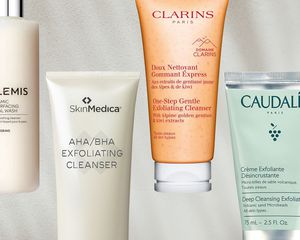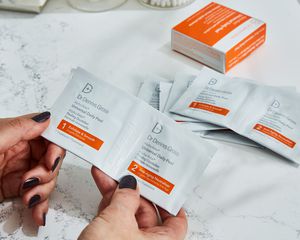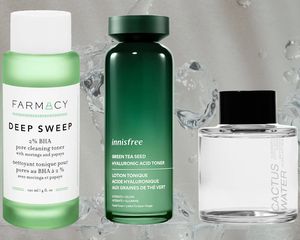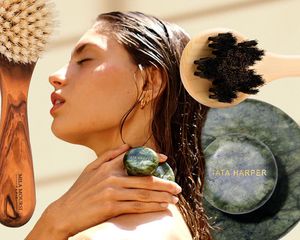:max_bytes(150000):strip_icc()/sea-salt-39d3bad2af194b6bb1d8ee2469e1a545.jpg)
Getty Images
There's no shortage of skincare hacks that have gone viral on TikTok, but the latest social media trend almost took down the internet. Earlier this year, one TikTok user's video rapidly racked up over 4 million views when she used a DIY sea salt spray to purportedly clear up her acne. If the idea that all it takes to score clear skin is sea salt and water sounds too good to be true...well, you're on the right track. While sea salt may have some benefits for your skin, it's hardly the end-all-be-all acne cure the internet has made it out to be. Here, Claire Chang, MD, a board-certified dermatologist at Union Square Laser Dermatology in New York City, and Mona Gohara, MD, associate clinical professor of dermatology at the Yale School of Medicine, explain why, and weigh in on what else you need to know.
Sea Salt
Type of ingredient: Salt that contains naturally occurring minerals
Main benefits: Anecdotally, it's said to have anti-inflammatory and antibacterial properties, though the scientific evidence backing this is limited (and even more so as it pertains to acne-specific benefits), says Chang. It is a natural exfoliant and can be effective for this purpose, so long as it is used properly.
Who should use it: Chang says it can be used by those who have dull, rough, or dry skin. Gohara says it may be somewhat beneficial for those with oily skin and occasional blemishes, though this hinges largely on the caveat that it's used correctly. (More on that in a moment.)
How often can you use it: Daily or a few times per week, depending on your skin type and how it's being used
Works well with: Light, hydrating ingredients, such as hyaluronic acid, and non-irritating, anti-inflammatory ingredients, such as niacinamide, says Gohara.
Don't use with: Retinoids or salicylic or glycolic acids, which can lead to overdrying of the skin, cautions Gohara.
What Is Sea Salt?
Simply put, it's the salt derived from seawater, which contains naturally occurring minerals such as sodium, magnesium, calcium, and potassium, explains Chang. It's (obviously) used in seasoning, cooking, and preserving food, though it's also found in bath products and skincare. And no, this isn't the same thing as iodized or table salt.
Benefits of Sea Salt for Skin
Let's start with a very big, very important caveat here. "There's limited evidence in the scientific literature about sea salt's benefits," says Chang. "And there have been no studies on its benefits for the treatment of acne," she goes on to say. That being said, there are anecdotal reports and suggestions that sea salt may do a few good things for skin.
- It is a natural physical exfoliant: There's good reason why there are salt scrubs galore. Its exfoliative properties are why it's been said to be beneficial for those with psoriasis, says Gohara. Chang cites one small study, published in the International Journal of Dermatology, that found that bathing in a magnesium-rich salt solution from the Dead Sea was shown to help improve skin roughness, redness, and even hydration in eczema patients. (Though the key point here is that it was bathing in this solution, not scrubbing with the salt—more on that to come.)
- It may have anti-inflammatory properties: This is likely due to the high mineral content, though again, this isn't scientifically backed.
- It can help absorb excess oil: According to Gohara, this, coupled with potential anti-inflammatory and antibacterial effects, is why it could theoretically be beneficial for acne-prone skin. "The salt absorbs excess oil, which is often a problem given that sebum is an acne precursor," she explains.
However, she goes on to dispute the internet-rampant myth that another reason why sea salt is good for acne is because it "balances your skin's pH." "It actually has an alkaline-basic pH of about 8," she explains.
Side Effects of Sea Salt
In short, the side effects are dryness and irritation, which can then actually end up exacerbating any inflammation or even blemishes, says Gohara. "Using sea salt as an exfoliant, especially if rubbed aggressively, can lead to over-exfoliation, irritation, and even micro tears in the skin," adds Chang. Point being, the person using sea salt, and exactly how they are using it, makes all the difference.
How to Use It
For starters, forget the DIY thing. "I'd avoid any kind of DIY skincare recipes and instead choose ready-made products that contain additional soothing ingredients in the formula," says Gohara. If you want to see for yourself if there is anything to all those skin-clearing rumors, she suggests using a sea salt–infused face mist once daily, rather than using sea salt as an exfoliant and trying to scrub your acne away. It also bears mentioning that this is only an effective option if you have oily skin and/or just occasional blemishes; inflammatory or cystic acne needs much more extensive treatment, Gohara warns.
If you have rough or extra-dry skin, you can try using a sea salt scrub as an exfoliator; though, again, opt for an over-the-counter product that contains hydrating ingredients to ensure you don't overdry your skin. (Oh, and most important, reserve this for body only. Sea salt scrubs are way too intense for the more delicate skin on your face, no matter your skin type.) And there's no need to be overzealous with your scrubbing, the abrasive nature of the scrub will do the hard work for you. Alternately, Chang says she prefers sea salt–based bath soaks that you can simply lay in to reap the benefits (a nice option if you're battling breakouts on your back or chest), rather than using the salt crystals to physically exfoliate the skin.
The Best Products With Sea Salt
"I like this because you get the benefits of sea salt in a gentle, non-abrasive mist," says Gohara of one of her picks for those with oily or blemish-prone skin. "It's perfect to use as a primer before moisturizer in the morning or underneath any non-irritating skincare products at night, and a light spritz goes a long way."
If you do want to use sea salt as an exfoliating ingredient, make sure it's via a hydrating scrub, such as this one. On the salt side of things, it combines two different types of sea salt along with three other salts, plus a trio of moisturizing oils. Use a small amount, two to three times per week, and don't forget to apply lotion afterward.
Sea salt and Epsom salts make up the base of this soak, which is perfect to add to your pre-bedtime bath. Credit soothing and calming valerian root, chamomile, and lavender to help you unwind while you reap the benefits of the salt for your skin.



